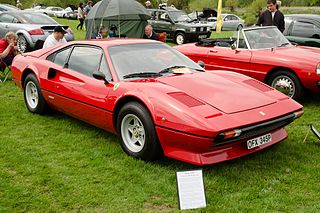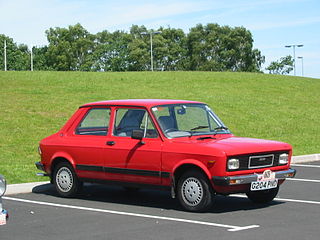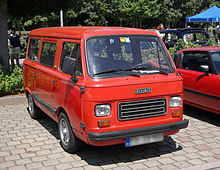
The Fiat 128 is a transverse front-engine, front wheel drive small family car manufactured and marketed by Fiat from 1969 to 1985 as a two- or four-door sedan, three- or five-door station wagon as well as two- or three-door coupé. The 128 running gear and engine, reconfigured for a mid-engined layout, were used in the Fiat X1/9 sports car.

The Fiat X1/9 is an Italian two-seater mid-engined sports car designed by Bertone and manufactured by Fiat from 1972–1982 and subsequently by Gruppo Bertone from 1982–1989.

The Fiat 127 is a supermini car produced by Italian car manufacturer Fiat from 1971 to 1983. It was introduced in 1971 as the replacement for the Fiat 850. Production of the 127 in Italy ended in 1983 following the introduction of its replacement, the Fiat Uno, although the nameplate continued to be used on cars imported from Brazil.

The Fiat 500 is an economy / city car that was manufactured and marketed by Fiat Automobiles from 1957 until 1975. It was sold as a two-door semi-convertible or saloon car and as a three-door panel van or estate car.

The Volkswagen Type 2 is a forward control light commercial vehicle introduced in 1950 by the German automaker Volkswagen as its second car model. Known officially as the Transporter, Kombi or Microbus, or, informally, as the Volkswagen Station Wagon (US), Bus, Camper (UK) or Bulli (Germany), it was given the factory designation Type 2 as it followed – and was initially derived from – Volkswagen's first model, the Type 1 (Beetle).

The Renault Trafic is a light commercial van produced by the French automaker Renault since 1980. It has also been marketed as the Fiat Talento, the Nissan NV300, the Nissan Primastar and the Mitsubishi Express. Until 2018, it was also sold as the Opel/Vauxhall Vivaro by Opel and its associated company Vauxhall. From early 2022 onwards, the van is also marketed by Renault Trucks as the Renault Trucks Trafic.

The GAZelle is a series of light commercial vehicle—pickup trucks, vans and minibuses—made by Russian car manufacturer GAZ. At the time of the dissolution of the Soviet Union and transition to a market economy, the Russian automobile industry had not produced a much-demanded LCV similar to the Ford Transit or VW T4 class. The GAZelle shares many parts with the company's passenger cars ; in fact, models produced until 1998 had the same grille. Riga Autobus Factory, which formerly manufactured minibuses for the whole USSR, remained in Latvia, and now required its vehicles be sold to the now-foreign Russian market for hard currency. Responding to this market opportunity, GAZ swiftly developed its own LCV called GAZelle, which, taken together with its lighter version, Sobol, now account for the majority of the Russian van and light truck market and have strong positions in the markets of other CIS countries, ranking as GAZ's most popular and successful products.

The Ferrari 308 GTB berlinetta and targa topped 308 GTS are V8 mid-engined, two-seater sports cars manufactured by the Italian company Ferrari from 1975 until 1985. The 308 replaced the Dino 246 GT and GTS in 1975 and was updated as the 328 GTB/GTS in 1985. The similar 208 GTB and GTS were equipped with a smaller, initially naturally aspirated and later turbocharged, two-litre engine, and were sold mainly in Italy.

The Dodge Ram Van is a range of full-size vans that were produced by Chrysler Corporation from the 1971 to 2003 model years. Replacing the Dodge A100, the Ram Van transitioned to a front-engine drivetrain configuration. Mostly offered as a cargo van and a passenger van, the model line was also initially offered as a cutaway van chassis.

The Fiat 600 is a small, rear-engined city car and economy family car made by Italian carmaker Fiat from 1955 to 1969 — offered in two-door fastback sedan and four-door Multipla mini MPV body styles. The 600 is considered a pop icon of the Italian economic miracle, and the three-row seating Multipla, though diminutive and odd-looking, is seen as one the first mass-produced minivans.

The Fiat 1100 is a small family car produced from 1953 until 1969 by the Italian manufacturer Fiat. It was an all-new unibody replacement for the Fiat 1100 E, which descended from the pre-war, body-on-frame Fiat 508 C Balilla 1100. The 1100 was changed steadily and gradually until being replaced by the new Fiat 128 in 1969. There were also a series of light commercial versions of the 1100 built, with later models called the Fiat 1100T, which remained in production until 1971. The Fiat 1100 D also found a long life in India, where Premier Automobiles continued to build the car until the end of 2000.

The Fiat Fiorino is a small commercial vehicle produced by the Italian car manufacturer Fiat since 1977. Its first two generations have been the panel van derivatives of other small models, such as the Fiat 127 and Fiat Uno, while the current third generation was developed jointly with PSA Peugeot Citroën, and is based on the Fiat Small platform.

The Fiat Argenta is a large family car produced by the Italian automobile company Fiat from 1981 to 1985. It was a comprehensive update of the Fiat 132 and the last mass-produced Fiat with rear-wheel drive until the 2016 124 Spider. The change to a name came about as Fiat was changing their naming strategy, changing from three-digit numbers to more meaningful names. This model was available in sedan/saloon bodystyle only.

The Fiat 850 is a small rear-engine, rear-wheel-drive car manufactured and marketed by Italian car manufacturer Fiat from 1964 to 1973.

Zastava Skala, also known as Yugo Skala, is a generic name for a family of cars built by Yugoslav, Serbian, manufacturer Zastava Automobili. Based on the Fiat 128 sedan, it was introduced in 1971 and sold as a 3 or 5-door liftback, a style that had not been issued or manufactured in Italy and was specifically trageted for the Balkan market, under the names Zastava 101, Zastava 1100, Zastava 1300,Zastava GTL, Yugo Skala 55c and Yugo Skala 65c.

The LDV Convoy is a light commercial van that was manufactured from 1986 until 2006. The Convoy was a development of the Leyland DAF 400 Series, which in turn was based on the Freight Rover 300 Series. The Convoy and its predecessors were wider and longer versions of the LDV Pilot, all based on the Leyland Sherpa series of vans from 1974.

The Alfa Romeo Romeo is a light commercial, cabover van and pickup truck that was introduced by the Italian automaker Alfa Romeo in 1954 as the Alfa Romeo Autotutto. The line of vans continued to be built until 1983, when it was replaced by relabelled Fiat and Iveco commercials. In Spain, where this vehicle was also built, it was rebodied and kept in production into the early 2000s, first as an Ebro or Avia and finally as the Nissan Trade.

The Chevrolet Van or Chevy Van is a range of vans that was manufactured by General Motors from the 1964 to 1996 model years. Introduced as the successor for the rear-engine Corvair Corvan/Greenbrier, the model line also replaced the panel van configuration of the Chevrolet Suburban. The vehicle was sold both in passenger van and cargo van configurations as well as a cutaway van chassis that served as the basis for a variety of custom applications.

The sixth generation of the Ford F-Series, also known as the "dentside Ford" to enthusiasts, is a line of pickup trucks and medium-duty commercial trucks that were produced by Ford Motor Company from the 1973 to 1979 model years. Produced by Ford in North America, Argentina, and Australia, this is the third and final generation of trucks derived from the 1965 Ford F-Series.

Designed by Dante Giacosa, the Fiat 100 engine first appeared in a 633 cc (38.6 cu in) form in the all-new Fiat 600 in 1955. The in-line four-cylinder engine comprised an iron block and an aluminium cylinder head with pushrod actuated valves. The engine was produced at Fiat's Mirafiori (Turin) plant, and then at Bielsko-Biała, and remained in production until 2000, used in Fiat Panda and Fiat Seicento in its last 899 cc (54.9 cu in) capacity version fitted with SPI single-point injection and hydraulic tappets, although slowly being phased out starting from 1985 in favour of the new Fiat FIRE engine.























